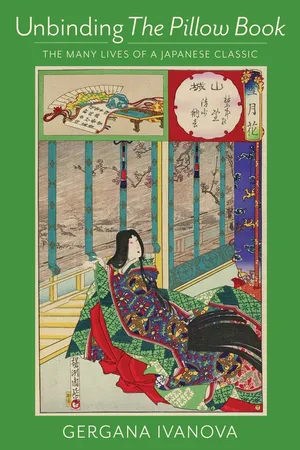Notes
1. WHAT IS THE PILLOW BOOK?
1. NHK is Japan’s national broadcasting organization. Haru wa akebono appears as the title of the first section of The Pillow Book in many modern editions. Historically, however, the phrase marked the beginning of the work as part of the larger narrative.
2. I use the terms “pleasure quarters” and “pleasure districts” throughout as translations of the Japanese euphemisms yūkaku and yūri.
3. In addition to the History’s Secret Stories episode mentioned earlier, another source that describes The Pillow Book as a blog is Machiko Midorikawa, “Reading a Heian Blog: A New Translation of Makura no Sōshi,” review of The Pillow Book, by Sei Shōnagon, trans. Meredith McKinney, Monumenta Nipponica 63, no. 1 (spring 2008): 143–60.
4. Motosuke belonged to the group of the Five Men of the Pear Chamber (Nashitsubo no Gonin). The other four members were Ōnakatomi no Yoshinobu (921–991), Minamoto no Shitagō (911–983), Sakanoue no Mochiki (d. 957?), and Ki no Tokibumi (dates unknown). Commissioned by Emperor Murakami (926–967, r. 946–967), the five poets and scholars compiled the second imperial anthology of Japanese poetry and added glosses to The Collection of Ten Thousand Leaves (Man’yōshū, late eighth century) to make it readable in Japanese. The Thirty-Six Poetry Immortals refers to a list of the most accomplished Japanese poets from the eighth century to the mid-Heian period identified by Fujiwara no Kintō in the eleventh century.
5. Miyakawa Yōko, “Fujiwara no Teishi,” in Makura no sōshi daijiten, ed. Makura no Sōshi Kenkyūkai (Tokyo: Bensei Shuppan, 2001), 538.
6. Paper was a precious commodity in the Heian period.
7. Mitamura Masako, Makura no sōshi: Hyōgen no ronri (Tokyo: Yūseidō Shuppan, 1995); Naomi Fukumori, “Sei Shōnagon’s Makura no sōshi: A Re-visionary History,” Journal of the Association of Teachers of Japanese 31, no. 1 (April 1997): 1–44.
8. Haruo Shirane, ed., Traditional Japanese Literature: An Anthology, Beginnings to 1600 (New York: Columbia University Press, 2007), 248.
9. Kigoshi Takashi, “Shutten, gensen, senshō,” in Makura no sōshi: Shosetsu ichiran, ed. Shioda Ryōhei, 133–64 (Tokyo: Meiji Shoin, 1970); Yahagi Takeshi, “Makura no sōshi to kanseki,” in Makura no Sōshi Kenkyūkai, Makura no sōshi daijiten, 599–615.
10. Joshua S. Mostow, “Mother Tongue and Father Script: Sei Shōnagon and Murasaki Shikibu,” in The Father-Daughter Plot: Japanese Literary Women and the Law of the Father, ed. Rebecca L. Copeland and Esperanza Ramirez-Christensen (Honolulu: University of Hawai`i Press, 2001), 121–27.
11. Jonathan Chaves, “Chinese Poems in Wakan rōei shū,” in Japanese and Chinese Poems to Sing: The “Wakan rōei shū,” trans. and annot. J. Thomas Rimer and Jonathan Chaves (New York: Columbia University Press, 1997), 20–25.
12. Minamoto no Tsunefusa was a middle general of the left from 998 until 1015. See Matsuo Satoshi and Nagai Kazuko, eds., Makura no sōshi: Nōinbon, Genbun ando gendaigoyaku shirīzu (Tokyo: Kasama Shoin, 2008), 365.
13. Ikeda Kikan, “Makura no sōshi no genkei to sono seiritsu nendai,” in Kenkyū Makura no sōshi (Tokyo: Shibundō, 1963), 30–31.
14. Matsuo and Nagai, Makura no sōshi, 369.
15. Tanaka Jūtarō, “Shohon no denryū,” in Makura no sōshi hikkei, ed. Kishigami Shinji (Tokyo: Gakutōsha, 1967), 32.
16. Ikeda Kikan, “Sei Shōnagon Makura no sōshi genson shohon no kaisetsu,” in “Sei Shōnagon Makura no sōshi no ihon ni kansuru kenkyū,” special issue, Kokugo to kokubungaku 5, no. 1 (1928): 83–184
17. Gergana Ivanova, “Textual Variations of Sei Shōnagon’s Makura no sōshi: Perception of the Text and the Narratorial Voice” (master’s thesis, University of Toronto, 2006).
18. Examples include Nagai Kazuko, “Dōtai toshite no Makura no sōshi: Honmon to sakusha to,” Kokubun 91 (August 1999): 10–19; Tsushima Tomoaki, Dōtai toshite no Makura no sōshi (Tokyo: Ōfūsha, 2005).
19. Hazama Tetsurō, “Makura no sōshi kenkyūshi,” in Gengo, gensen, eikyō, kenkyū, vol. 4 of Makura no sōshi kōza, ed. Yūseidō Henshūbu (Tokyo: Yūseidō, 1976), 304–7.
20. Ikeda Kikan was the first modern scholar to draw attention to the Sankanbon textual line by introducing extensively varying manuscripts within it; see Ikeda, “Sei Shōnagon Makura no sōshi,” 115–61. Two years earlier, a transliteration of two of the Sankanbon manuscripts was published for the first time. See Yamagishi Tokuhei, ed., Sei Shōnagon Makura no sōshi, in Nihon bungaku taikei: Kōchū, vol. 3 (Tokyo: Kokumin Tosho, 1926). In postwar Japan the annotated editions of the Sankanbon textual line that were commonly used for research include Tanaka Jūtarō, ed., Makura no sōshi, Nihon koten zensho (Tokyo: Asahi Shinbunsha, 1947); Ikeda Kikan and Kishigami Shinji, Makura no sōshi, Nihon koten bungaku taikei (Tokyo: Iwanami Shoten, 1958); Ishida Jōji, ed., Ma...
